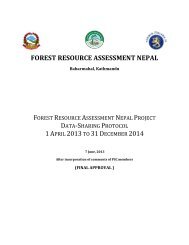Download - FRA Nepal
Download - FRA Nepal
Download - FRA Nepal
You also want an ePaper? Increase the reach of your titles
YUMPU automatically turns print PDFs into web optimized ePapers that Google loves.
Some of the high resolution satellite images applicable for forest monitoring and mapping are ALOS/Prism, IKONOS/Geo,<br />
RapidEye, GeoEye and Quick Bird. Thematic maps will be produced by using the images and ground truthing. These<br />
thematic maps will be further used as basic data to expand the maps of the medium resolution wall-to-wall data.<br />
The inventory could be done by using medium resolution images data and low ground sampling intensity. The result will be<br />
with medium accuracy. However, <strong>FRA</strong> is going to replace medium resolution data by using Very High Resolution (VHR)<br />
images to improve the quality of overall data and maps. Furthermore, the maps from the VHR data can be used to serve<br />
forest management planning. Besides, the project will evaluate on how VHR image data facilitate to decrease field sampling<br />
intensity.<br />
ICIMOD has good experience in using very high resolution data in land use classification and object based analysis in<br />
mountainous area. This project will make an appropriate strategy to collaborate with ICIMOD.<br />
Visual interpretation is the baseline method for the interpretation of the VHR images. Further, numerical (e.g. KLM method)<br />
interpretation is another way to analyze the images. The project will develop the numerical analysis methods, if the research<br />
and development part of the project permit. Interpreting methods for forest types, stocking levels, TOF, biodiversity/habitats,<br />
NTFP, etc. must be developed. The field data obtained from the field inventory can be used for training sample.<br />
Interpretation by using field sample plots and methodology used in Scandinavian and US national forest inventories can be<br />
considered as one alternative model. A manual must be produced for visual and numerical interpretation and training will be<br />
given to the staff members about the methods.<br />
The objectives of image interpretations are:<br />
1. Initial classification gives idea to designate grid and field plots;<br />
2. Assessing the amount of TOFs;<br />
3. Potential change detection using aerial photos of 1990’s or LRMP maps as a reference material;<br />
4. Providing the medium resolution remote sensing images for the thematic wall-to-wall map production.<br />
The TOF assessment can be made following the recommendations given by Dr. Kleinn (Dr. Christoph Kleinn: “Forest<br />
Resource Inventories in <strong>Nepal</strong>: Status Quo, Needs, Recommendations”, chapter 8.1.1.6) and taking advantage of the<br />
experiences gained by DFRS in the pilot assessment of TOF in Morang, Dhanusa and Nawalparasi districts. The aerial<br />
photos used in the Finnish funded mapping project in the 1990’s provide an excellent material for forest change detection.<br />
7.2.3.2 Air-Borne Laser Scanning (ALS)<br />
Airborne laser scanning, LiDAR (Light Detection and Ranging) is an active remote sensing technique. An airplane or<br />
helicopter-mounted sensor sends laser pulses towards ground and records the elapsed time between beam launch and return<br />
signal registration. The accurate reflection point location can be calculated using the following information: time taken by a<br />
beam to return to the sensor, the beam shooting direction, the position and altitude of the sensor recorded with a Global<br />
Navigation Satellite System receiver (GNSS) and inertial measurement unit (IMU).<br />
Some of the LiDAR pulses are reflected from tree canopy, trunks, branches, leaves or lower vegetation, but they also<br />
penetrate through the canopy layer to reach the ground, thereby profiling a three-dimensional point cloud image of the forest.<br />
LiDAR flight missions can be operated at day or night time. There have been several studies on LiDAR inventory<br />
applications in the mountainous areas and forests around the world.<br />
Advantages of LiDAR<br />
New technology has been introduced for measuring ground information for estimation of vegetation cover, carbon and<br />
biomass. Airborne LiDAR can be employed as a tool to accurately estimate forest volume, above-ground forest biomass and<br />
carbon. LiDAR is able to capture the entire 3-dimensional structure of vegetation canopies. Studies in the United States,<br />
Latin America, the Lao Republic and Scandinavian countries have indicated that LiDAR is one of the most efficient remote<br />
sensing methods for estimation of biomass and carbon.<br />
Moreover, airborne LiDAR is the only technology, so far, which allows forest measurements to be taken in the vertical<br />
direction with high precision and efficiency. It allows mapping on the steep hill slopes or otherwise inaccessible terrain<br />
conditions. LiDAR has been widely used for accurate digital elevation model (DEM) generation, which provides a costefficient<br />
and straight-forward work-flow in comparison to photogrammetric stereo-mapping methodology.<br />
27





